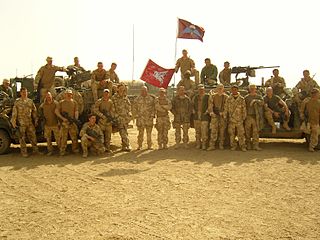
The Royal Logistic Corps provides logistic support functions to the British Army. It is the largest Corps in the Army.

The Royal Corps of Transport (RCT) was a British Army Corps established to manage all matters in relation to the transport of men and material for the Army and the wider Defence community. It was formed in 1965 and disbanded in 1993; its units and trades were amalgamated into the Royal Logistic Corps. The Depot and Training Regiment RCT was at the former Buller Barracks in Aldershot garrison.

321 EOD & Search Squadron 11 EOD Regiment RLC is a unit of the British Army responsible for Explosive Ordnance Disposal and Search duties in Northern Ireland.

HQ Northern Ireland was the formation responsible for the British Army in and around Northern Ireland. It was established in 1922 and disbanded, replaced by a brigade-level Army Reserve formation, 38 (Irish) Brigade, in 2009.
154 (Scottish) Regiment is a regiment of the British Army's Royal Logistic Corps. It forms part of the Army Reserve. Its role is to provide general transport support at 'third line' for the British Army.
156 Regiment RLC is an Army Reserve Regiment of the British Army's Royal Logistic Corps.
160 Transport Regiment Royal Logistic Corps (Volunteers), was a regiment of the Territorial Army in the United Kingdom.

15 Air Assault Support Squadron is a British Army logistic squadron, currently under 13 Air Assault Support Regiment RLC.

The Defence School of Transport (DST) Leconfield is located at Normandy Barracks, Leconfield near Beverley, East Riding of Yorkshire in England.

Palace Barracks, Holywood is a military installation and the Northern Ireland headquarters of MI5, in Holywood, County Down, Northern Ireland.
157 (Welsh) Regiment RLC is an Army Reserve regiment of the Royal Logistic Corps.

The Duke of Gloucester Barracks is a British Army barracks at South Cerney in Gloucestershire.

104 Theatre Sustainment Brigade is a specialist logistic support formation of the British Army. The brigade is the only one of its kind, and as such contains many of the special units of the Royal Logistic Corps and Royal Electrical and Mechanical Engineers.
6 Regiment RLC is a regiment of the Royal Logistic Corps of the British Army.
7 Regiment RLC is a regiment of the British Army's Royal Logistic Corps.

17 Port and Maritime Regiment is a regiment of the British Army's Royal Logistic Corps. The unit is the Army's only regular Port & Maritime capability, though it is twinned with 165 Port and Maritime Regiment RLC, of the Army Reserve.

The structure of the British Army is being reorganised to the Future Soldier structure. The Army is commanded by the Chief of the General Staff (CGS), with Army Headquarters which is located in Andover, Hampshire. Subordinate to that post, there is a Commander Field Army, and a personnel and UK operations command, Home Command.
The following is a hierarchical outline for the structure of the British Army in 1989. The most authoritative source for this type of information available is Ministry of Defence, Master Order of Battle, and United Kingdom Land Forces, HQ UKLF, UKLF ORBAT Review Action Plan, HQ UKLF, 1990.
The 2nd Division Transport Regiment was a military support unit of the British Army, forming part of the Royal Corps of Transport. Initially formed in 1953, the regiment would serve the 2nd Infantry Division until its first disbandment in 1984 following a reorganisation of the British Army of the Rhine. Reformed one year later, it would finally be disbanded in 1993 following the End of the Cold War.










